Financial Resource Management: Metro Products Ltd. Report and Analysis
VerifiedAdded on 2020/01/16
|12
|3404
|167
Report
AI Summary
This report provides an in-depth analysis of managing financial resources, focusing on Metro Products Ltd. It begins by differentiating between limited and non-limited companies, outlining legal requirements for financial year-end reporting. The report then explains the importance of key financial statements, including cash flow statements, profit and loss accounts, retained earnings accounts, and balance sheets. Furthermore, it explores the identification of potential stakeholders and their respective interests in the company, essential for strategic decision-making and financial planning. The report emphasizes the significance of these financial tools for maintaining financial health, attracting investors, and ensuring compliance with legal standards. The analysis is structured to provide a comprehensive understanding of financial management principles and their application within a real-world business context.
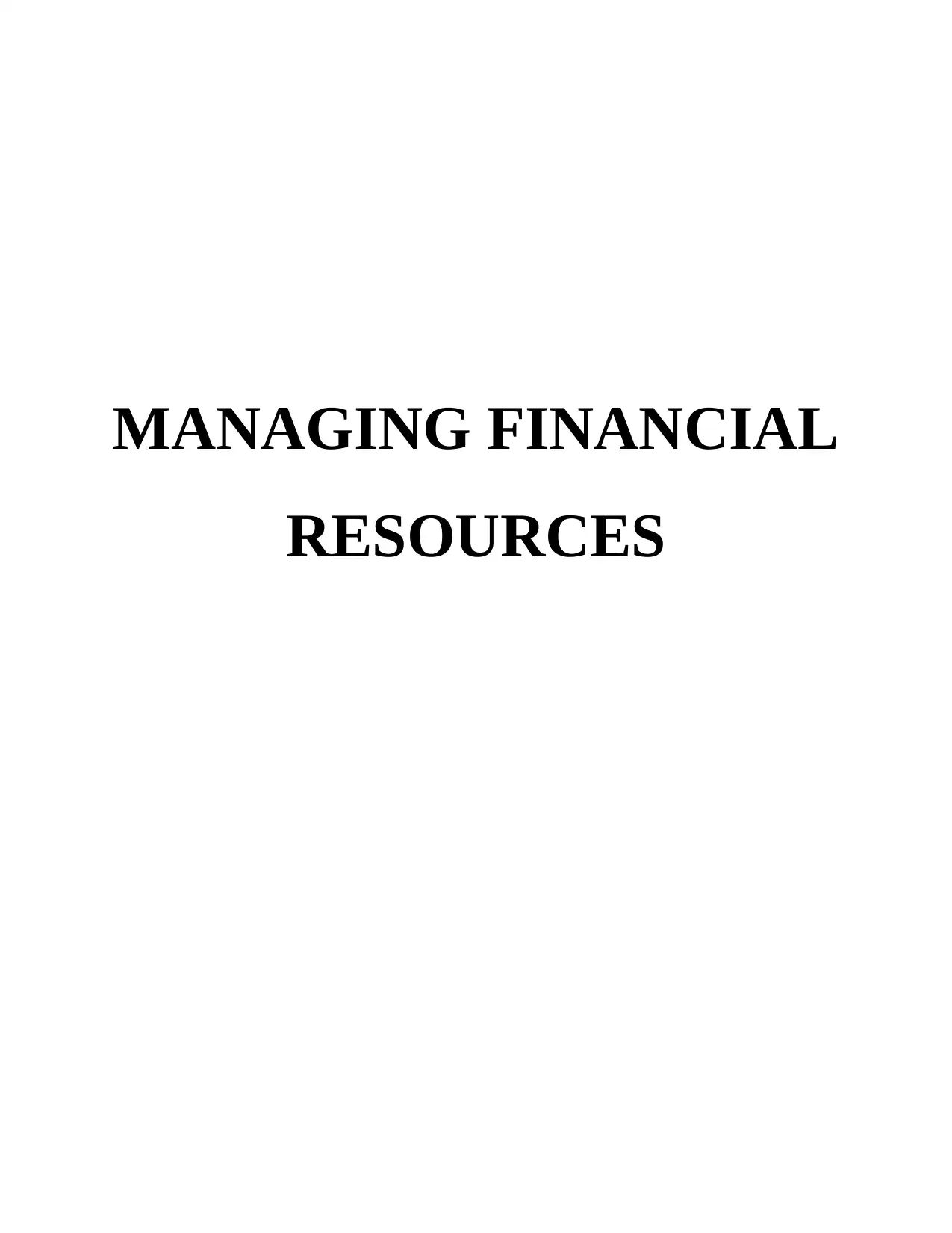
MANAGING FINANCIAL
RESOURCES
RESOURCES
Paraphrase This Document
Need a fresh take? Get an instant paraphrase of this document with our AI Paraphraser
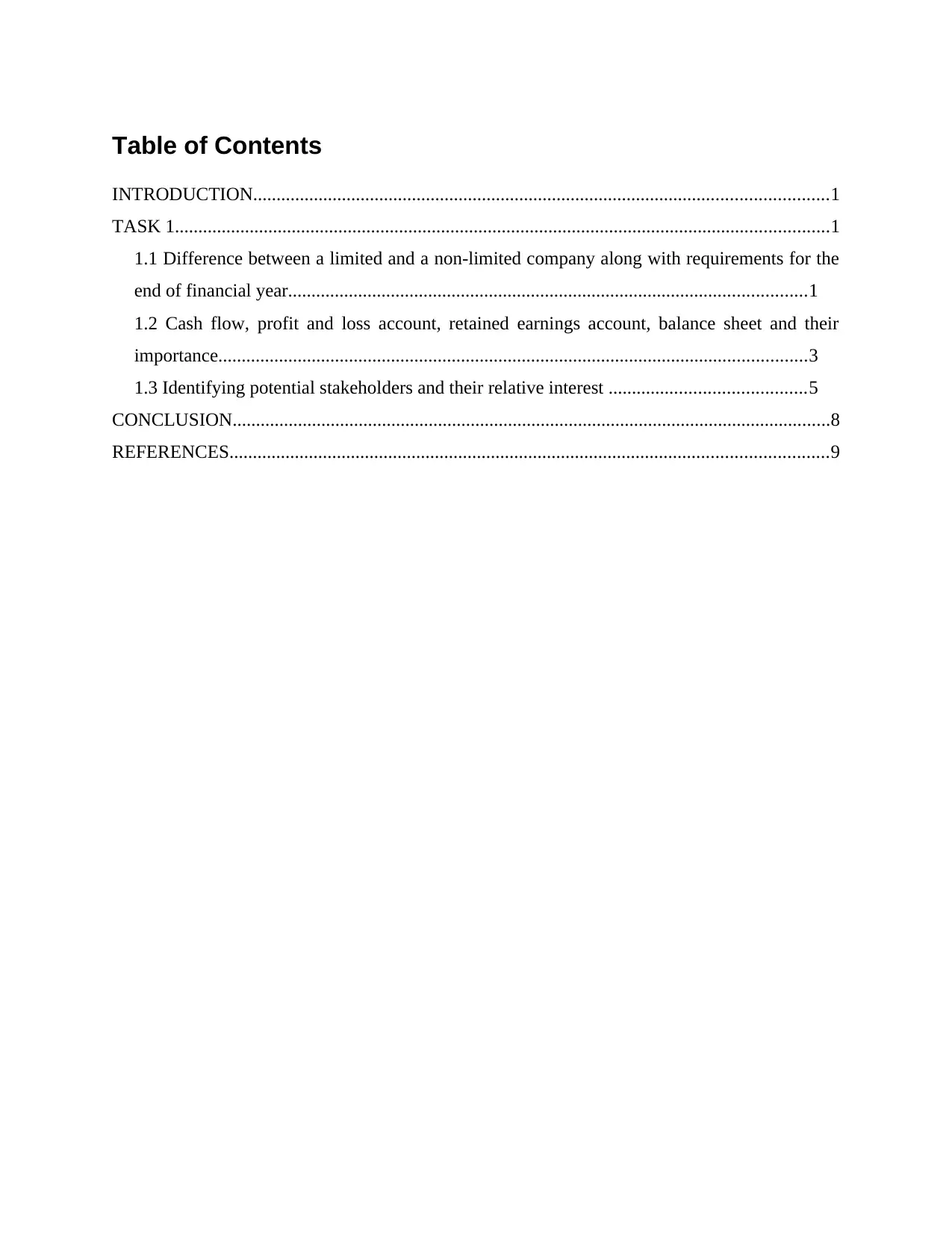
Table of Contents
INTRODUCTION...........................................................................................................................1
TASK 1............................................................................................................................................1
1.1 Difference between a limited and a non-limited company along with requirements for the
end of financial year...............................................................................................................1
1.2 Cash flow, profit and loss account, retained earnings account, balance sheet and their
importance..............................................................................................................................3
1.3 Identifying potential stakeholders and their relative interest ..........................................5
CONCLUSION................................................................................................................................8
REFERENCES................................................................................................................................9
INTRODUCTION...........................................................................................................................1
TASK 1............................................................................................................................................1
1.1 Difference between a limited and a non-limited company along with requirements for the
end of financial year...............................................................................................................1
1.2 Cash flow, profit and loss account, retained earnings account, balance sheet and their
importance..............................................................................................................................3
1.3 Identifying potential stakeholders and their relative interest ..........................................5
CONCLUSION................................................................................................................................8
REFERENCES................................................................................................................................9
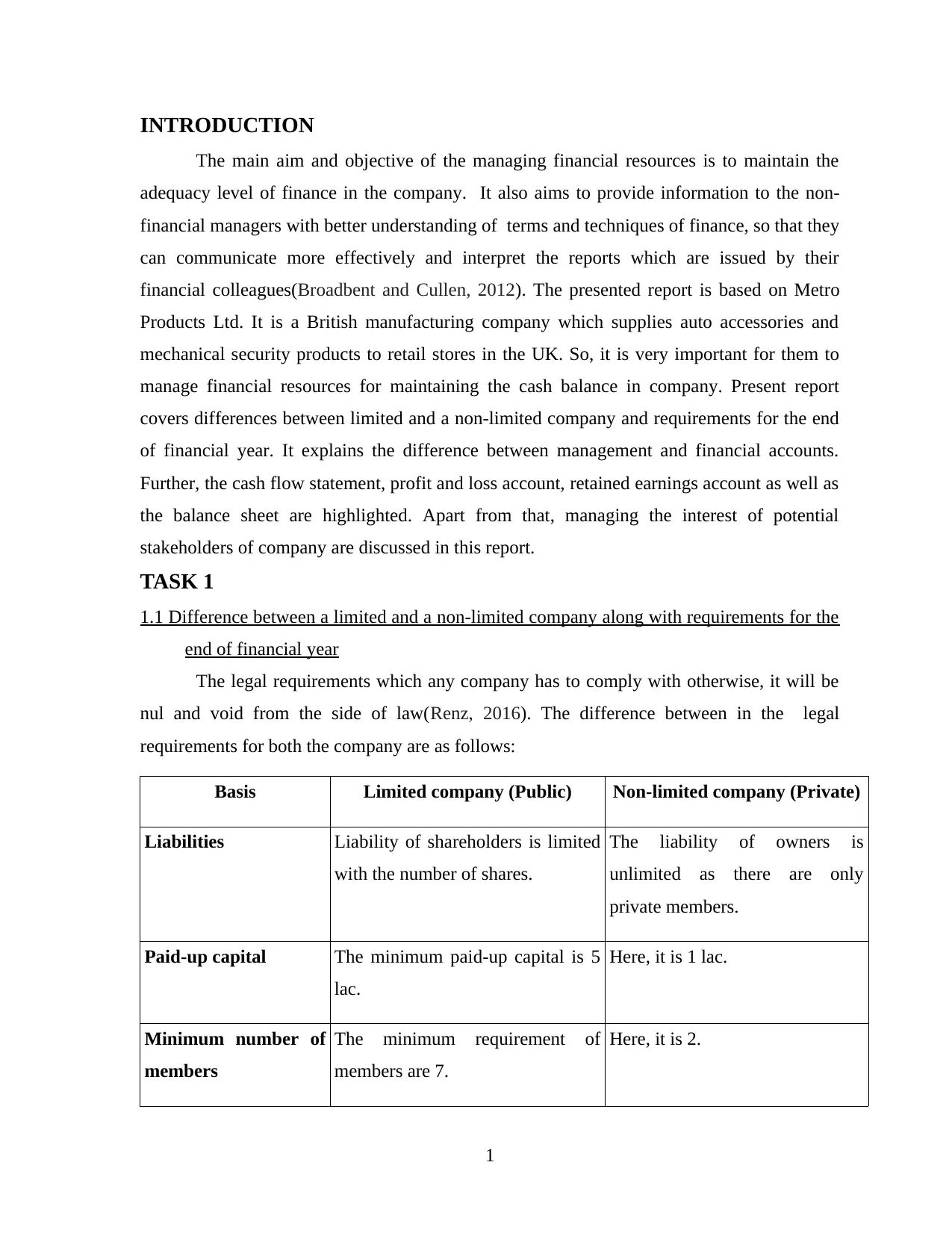
INTRODUCTION
The main aim and objective of the managing financial resources is to maintain the
adequacy level of finance in the company. It also aims to provide information to the non-
financial managers with better understanding of terms and techniques of finance, so that they
can communicate more effectively and interpret the reports which are issued by their
financial colleagues(Broadbent and Cullen, 2012). The presented report is based on Metro
Products Ltd. It is a British manufacturing company which supplies auto accessories and
mechanical security products to retail stores in the UK. So, it is very important for them to
manage financial resources for maintaining the cash balance in company. Present report
covers differences between limited and a non-limited company and requirements for the end
of financial year. It explains the difference between management and financial accounts.
Further, the cash flow statement, profit and loss account, retained earnings account as well as
the balance sheet are highlighted. Apart from that, managing the interest of potential
stakeholders of company are discussed in this report.
TASK 1
1.1 Difference between a limited and a non-limited company along with requirements for the
end of financial year
The legal requirements which any company has to comply with otherwise, it will be
nul and void from the side of law(Renz, 2016). The difference between in the legal
requirements for both the company are as follows:
Basis Limited company (Public) Non-limited company (Private)
Liabilities Liability of shareholders is limited
with the number of shares.
The liability of owners is
unlimited as there are only
private members.
Paid-up capital The minimum paid-up capital is 5
lac.
Here, it is 1 lac.
Minimum number of
members
The minimum requirement of
members are 7.
Here, it is 2.
1
The main aim and objective of the managing financial resources is to maintain the
adequacy level of finance in the company. It also aims to provide information to the non-
financial managers with better understanding of terms and techniques of finance, so that they
can communicate more effectively and interpret the reports which are issued by their
financial colleagues(Broadbent and Cullen, 2012). The presented report is based on Metro
Products Ltd. It is a British manufacturing company which supplies auto accessories and
mechanical security products to retail stores in the UK. So, it is very important for them to
manage financial resources for maintaining the cash balance in company. Present report
covers differences between limited and a non-limited company and requirements for the end
of financial year. It explains the difference between management and financial accounts.
Further, the cash flow statement, profit and loss account, retained earnings account as well as
the balance sheet are highlighted. Apart from that, managing the interest of potential
stakeholders of company are discussed in this report.
TASK 1
1.1 Difference between a limited and a non-limited company along with requirements for the
end of financial year
The legal requirements which any company has to comply with otherwise, it will be
nul and void from the side of law(Renz, 2016). The difference between in the legal
requirements for both the company are as follows:
Basis Limited company (Public) Non-limited company (Private)
Liabilities Liability of shareholders is limited
with the number of shares.
The liability of owners is
unlimited as there are only
private members.
Paid-up capital The minimum paid-up capital is 5
lac.
Here, it is 1 lac.
Minimum number of
members
The minimum requirement of
members are 7.
Here, it is 2.
1
⊘ This is a preview!⊘
Do you want full access?
Subscribe today to unlock all pages.

Trusted by 1+ million students worldwide
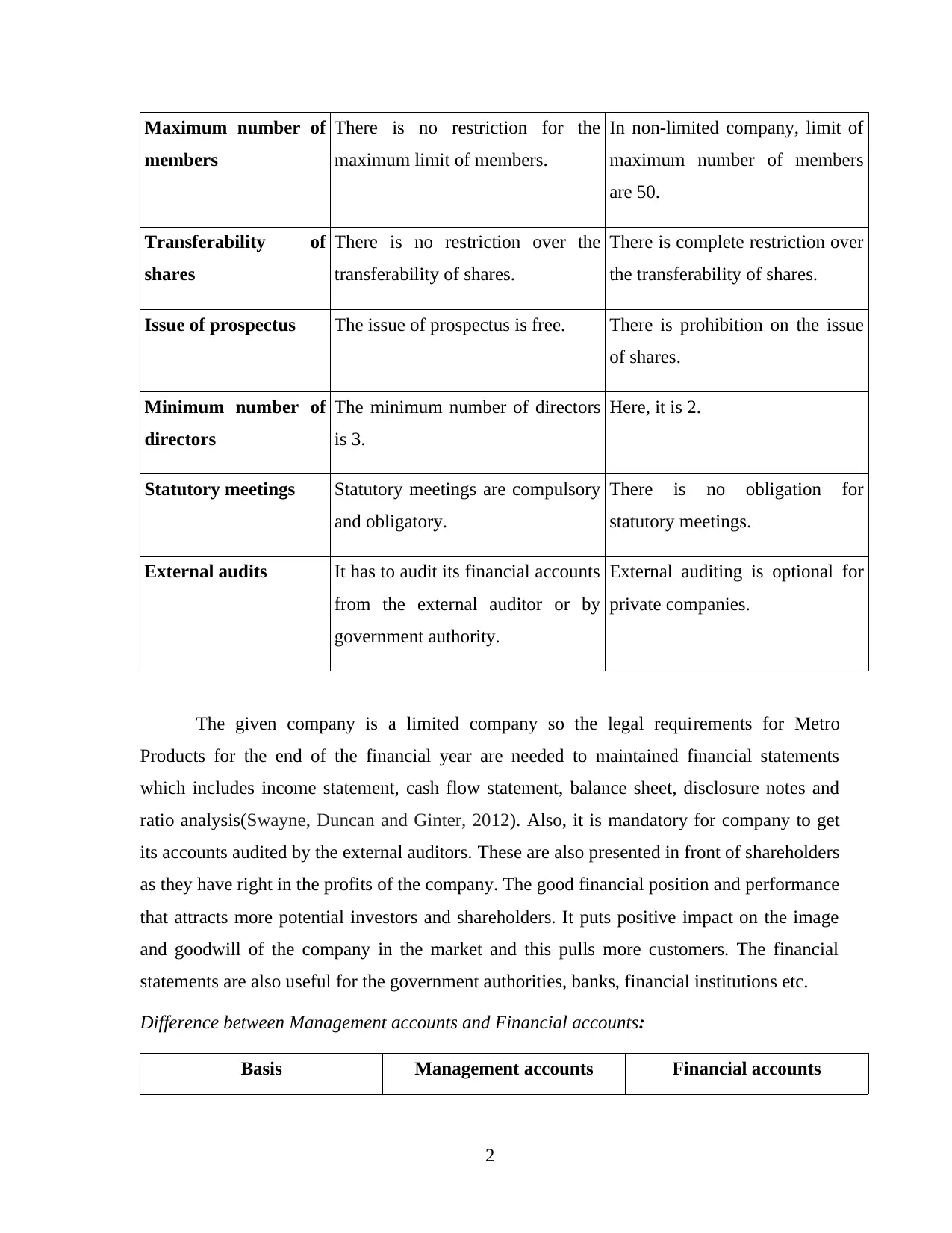
Maximum number of
members
There is no restriction for the
maximum limit of members.
In non-limited company, limit of
maximum number of members
are 50.
Transferability of
shares
There is no restriction over the
transferability of shares.
There is complete restriction over
the transferability of shares.
Issue of prospectus The issue of prospectus is free. There is prohibition on the issue
of shares.
Minimum number of
directors
The minimum number of directors
is 3.
Here, it is 2.
Statutory meetings Statutory meetings are compulsory
and obligatory.
There is no obligation for
statutory meetings.
External audits It has to audit its financial accounts
from the external auditor or by
government authority.
External auditing is optional for
private companies.
The given company is a limited company so the legal requirements for Metro
Products for the end of the financial year are needed to maintained financial statements
which includes income statement, cash flow statement, balance sheet, disclosure notes and
ratio analysis(Swayne, Duncan and Ginter, 2012). Also, it is mandatory for company to get
its accounts audited by the external auditors. These are also presented in front of shareholders
as they have right in the profits of the company. The good financial position and performance
that attracts more potential investors and shareholders. It puts positive impact on the image
and goodwill of the company in the market and this pulls more customers. The financial
statements are also useful for the government authorities, banks, financial institutions etc.
Difference between Management accounts and Financial accounts:
Basis Management accounts Financial accounts
2
members
There is no restriction for the
maximum limit of members.
In non-limited company, limit of
maximum number of members
are 50.
Transferability of
shares
There is no restriction over the
transferability of shares.
There is complete restriction over
the transferability of shares.
Issue of prospectus The issue of prospectus is free. There is prohibition on the issue
of shares.
Minimum number of
directors
The minimum number of directors
is 3.
Here, it is 2.
Statutory meetings Statutory meetings are compulsory
and obligatory.
There is no obligation for
statutory meetings.
External audits It has to audit its financial accounts
from the external auditor or by
government authority.
External auditing is optional for
private companies.
The given company is a limited company so the legal requirements for Metro
Products for the end of the financial year are needed to maintained financial statements
which includes income statement, cash flow statement, balance sheet, disclosure notes and
ratio analysis(Swayne, Duncan and Ginter, 2012). Also, it is mandatory for company to get
its accounts audited by the external auditors. These are also presented in front of shareholders
as they have right in the profits of the company. The good financial position and performance
that attracts more potential investors and shareholders. It puts positive impact on the image
and goodwill of the company in the market and this pulls more customers. The financial
statements are also useful for the government authorities, banks, financial institutions etc.
Difference between Management accounts and Financial accounts:
Basis Management accounts Financial accounts
2
Paraphrase This Document
Need a fresh take? Get an instant paraphrase of this document with our AI Paraphraser
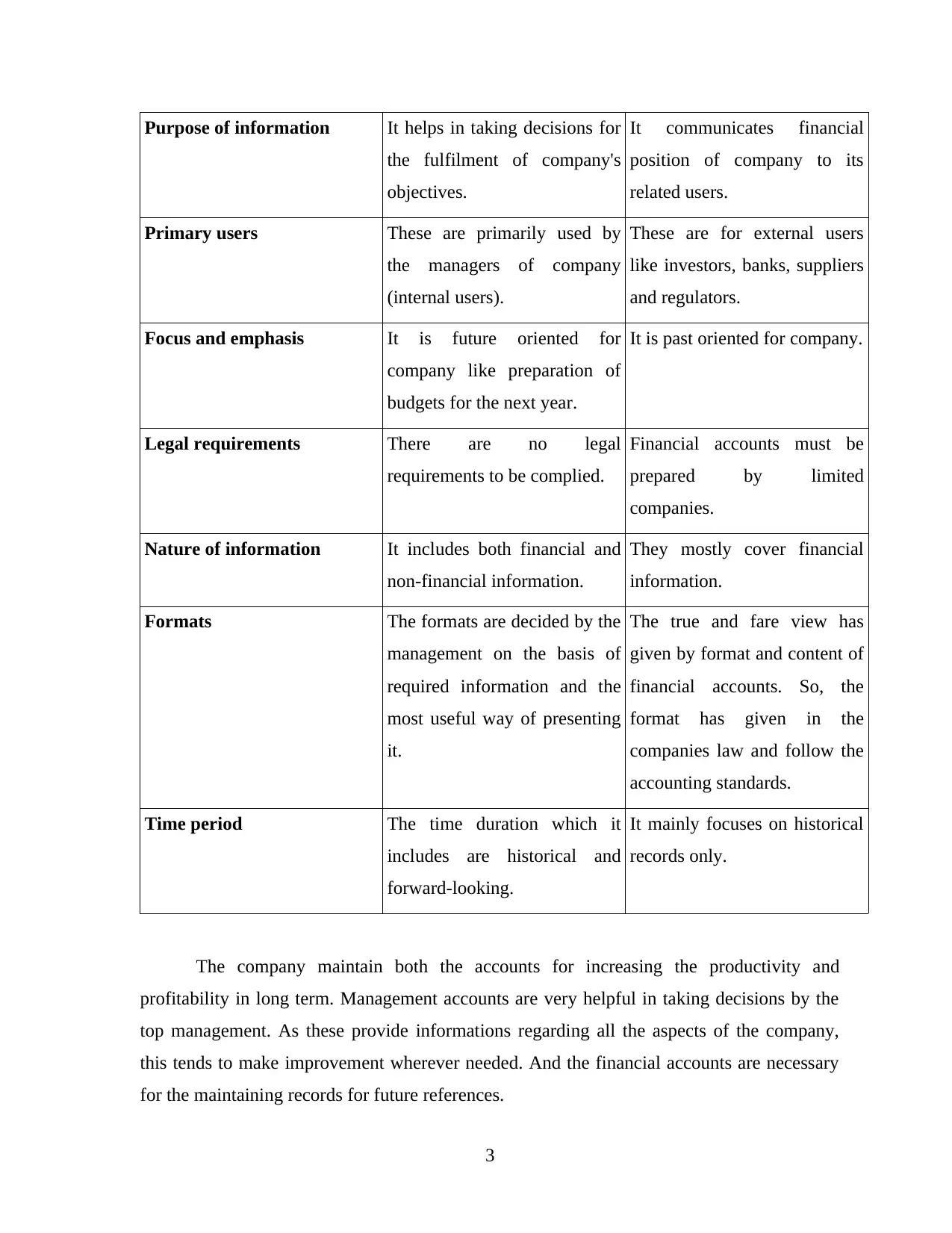
Purpose of information It helps in taking decisions for
the fulfilment of company's
objectives.
It communicates financial
position of company to its
related users.
Primary users These are primarily used by
the managers of company
(internal users).
These are for external users
like investors, banks, suppliers
and regulators.
Focus and emphasis It is future oriented for
company like preparation of
budgets for the next year.
It is past oriented for company.
Legal requirements There are no legal
requirements to be complied.
Financial accounts must be
prepared by limited
companies.
Nature of information It includes both financial and
non-financial information.
They mostly cover financial
information.
Formats The formats are decided by the
management on the basis of
required information and the
most useful way of presenting
it.
The true and fare view has
given by format and content of
financial accounts. So, the
format has given in the
companies law and follow the
accounting standards.
Time period The time duration which it
includes are historical and
forward-looking.
It mainly focuses on historical
records only.
The company maintain both the accounts for increasing the productivity and
profitability in long term. Management accounts are very helpful in taking decisions by the
top management. As these provide informations regarding all the aspects of the company,
this tends to make improvement wherever needed. And the financial accounts are necessary
for the maintaining records for future references.
3
the fulfilment of company's
objectives.
It communicates financial
position of company to its
related users.
Primary users These are primarily used by
the managers of company
(internal users).
These are for external users
like investors, banks, suppliers
and regulators.
Focus and emphasis It is future oriented for
company like preparation of
budgets for the next year.
It is past oriented for company.
Legal requirements There are no legal
requirements to be complied.
Financial accounts must be
prepared by limited
companies.
Nature of information It includes both financial and
non-financial information.
They mostly cover financial
information.
Formats The formats are decided by the
management on the basis of
required information and the
most useful way of presenting
it.
The true and fare view has
given by format and content of
financial accounts. So, the
format has given in the
companies law and follow the
accounting standards.
Time period The time duration which it
includes are historical and
forward-looking.
It mainly focuses on historical
records only.
The company maintain both the accounts for increasing the productivity and
profitability in long term. Management accounts are very helpful in taking decisions by the
top management. As these provide informations regarding all the aspects of the company,
this tends to make improvement wherever needed. And the financial accounts are necessary
for the maintaining records for future references.
3
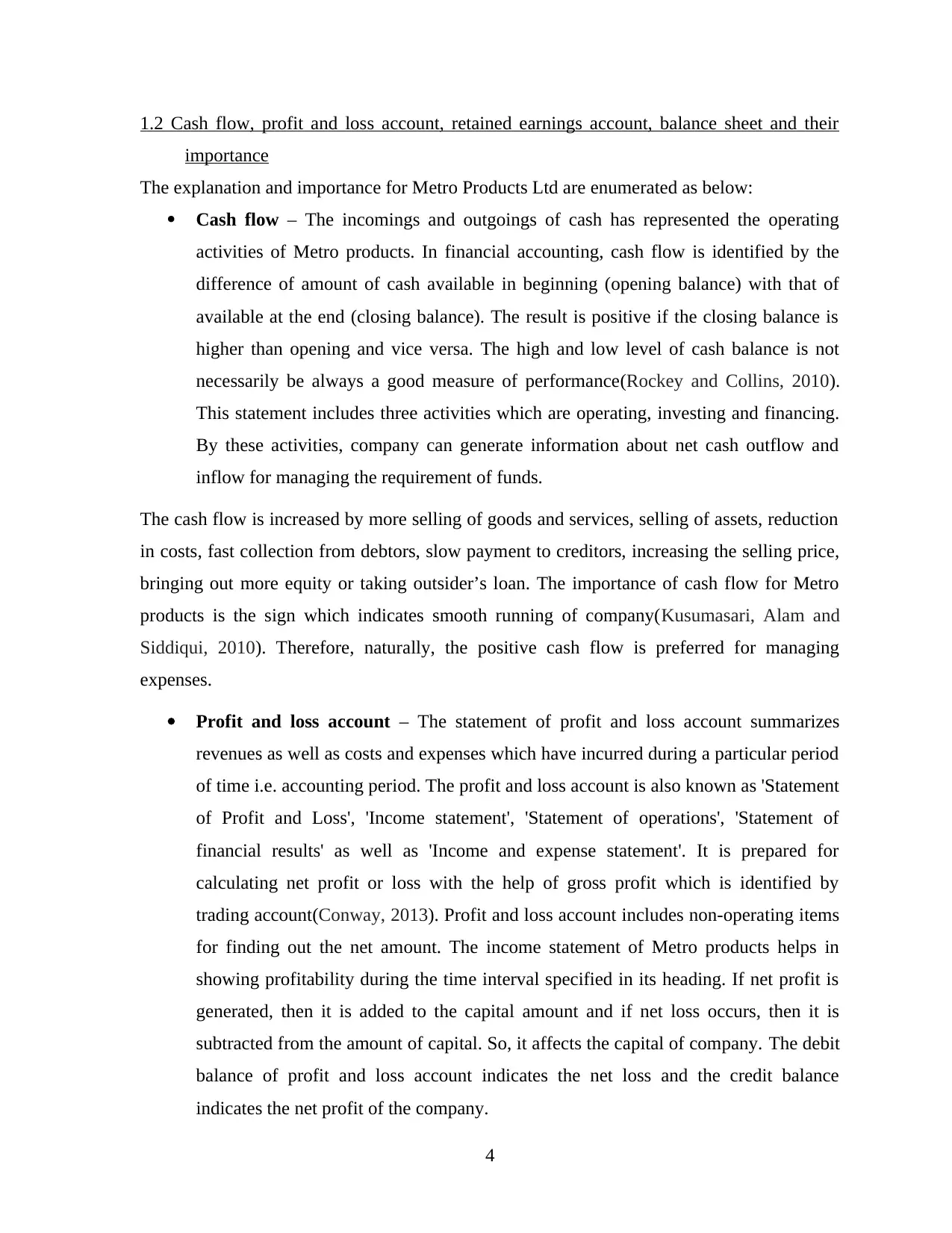
1.2 Cash flow, profit and loss account, retained earnings account, balance sheet and their
importance
The explanation and importance for Metro Products Ltd are enumerated as below:
Cash flow – The incomings and outgoings of cash has represented the operating
activities of Metro products. In financial accounting, cash flow is identified by the
difference of amount of cash available in beginning (opening balance) with that of
available at the end (closing balance). The result is positive if the closing balance is
higher than opening and vice versa. The high and low level of cash balance is not
necessarily be always a good measure of performance(Rockey and Collins, 2010).
This statement includes three activities which are operating, investing and financing.
By these activities, company can generate information about net cash outflow and
inflow for managing the requirement of funds.
The cash flow is increased by more selling of goods and services, selling of assets, reduction
in costs, fast collection from debtors, slow payment to creditors, increasing the selling price,
bringing out more equity or taking outsider’s loan. The importance of cash flow for Metro
products is the sign which indicates smooth running of company(Kusumasari, Alam and
Siddiqui, 2010). Therefore, naturally, the positive cash flow is preferred for managing
expenses.
Profit and loss account – The statement of profit and loss account summarizes
revenues as well as costs and expenses which have incurred during a particular period
of time i.e. accounting period. The profit and loss account is also known as 'Statement
of Profit and Loss', 'Income statement', 'Statement of operations', 'Statement of
financial results' as well as 'Income and expense statement'. It is prepared for
calculating net profit or loss with the help of gross profit which is identified by
trading account(Conway, 2013). Profit and loss account includes non-operating items
for finding out the net amount. The income statement of Metro products helps in
showing profitability during the time interval specified in its heading. If net profit is
generated, then it is added to the capital amount and if net loss occurs, then it is
subtracted from the amount of capital. So, it affects the capital of company. The debit
balance of profit and loss account indicates the net loss and the credit balance
indicates the net profit of the company.
4
importance
The explanation and importance for Metro Products Ltd are enumerated as below:
Cash flow – The incomings and outgoings of cash has represented the operating
activities of Metro products. In financial accounting, cash flow is identified by the
difference of amount of cash available in beginning (opening balance) with that of
available at the end (closing balance). The result is positive if the closing balance is
higher than opening and vice versa. The high and low level of cash balance is not
necessarily be always a good measure of performance(Rockey and Collins, 2010).
This statement includes three activities which are operating, investing and financing.
By these activities, company can generate information about net cash outflow and
inflow for managing the requirement of funds.
The cash flow is increased by more selling of goods and services, selling of assets, reduction
in costs, fast collection from debtors, slow payment to creditors, increasing the selling price,
bringing out more equity or taking outsider’s loan. The importance of cash flow for Metro
products is the sign which indicates smooth running of company(Kusumasari, Alam and
Siddiqui, 2010). Therefore, naturally, the positive cash flow is preferred for managing
expenses.
Profit and loss account – The statement of profit and loss account summarizes
revenues as well as costs and expenses which have incurred during a particular period
of time i.e. accounting period. The profit and loss account is also known as 'Statement
of Profit and Loss', 'Income statement', 'Statement of operations', 'Statement of
financial results' as well as 'Income and expense statement'. It is prepared for
calculating net profit or loss with the help of gross profit which is identified by
trading account(Conway, 2013). Profit and loss account includes non-operating items
for finding out the net amount. The income statement of Metro products helps in
showing profitability during the time interval specified in its heading. If net profit is
generated, then it is added to the capital amount and if net loss occurs, then it is
subtracted from the amount of capital. So, it affects the capital of company. The debit
balance of profit and loss account indicates the net loss and the credit balance
indicates the net profit of the company.
4
⊘ This is a preview!⊘
Do you want full access?
Subscribe today to unlock all pages.

Trusted by 1+ million students worldwide
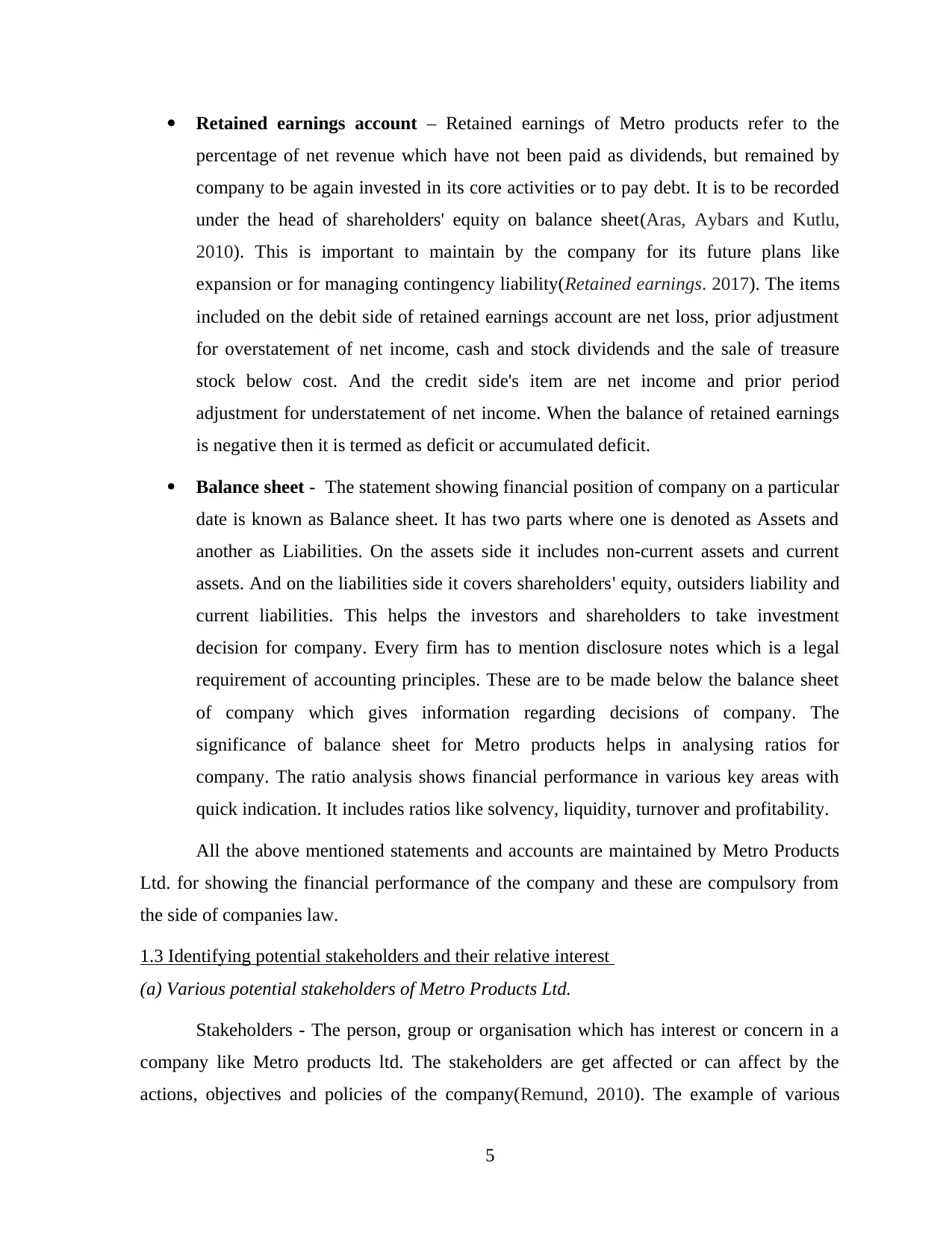
Retained earnings account – Retained earnings of Metro products refer to the
percentage of net revenue which have not been paid as dividends, but remained by
company to be again invested in its core activities or to pay debt. It is to be recorded
under the head of shareholders' equity on balance sheet(Aras, Aybars and Kutlu,
2010). This is important to maintain by the company for its future plans like
expansion or for managing contingency liability(Retained earnings. 2017). The items
included on the debit side of retained earnings account are net loss, prior adjustment
for overstatement of net income, cash and stock dividends and the sale of treasure
stock below cost. And the credit side's item are net income and prior period
adjustment for understatement of net income. When the balance of retained earnings
is negative then it is termed as deficit or accumulated deficit.
Balance sheet - The statement showing financial position of company on a particular
date is known as Balance sheet. It has two parts where one is denoted as Assets and
another as Liabilities. On the assets side it includes non-current assets and current
assets. And on the liabilities side it covers shareholders' equity, outsiders liability and
current liabilities. This helps the investors and shareholders to take investment
decision for company. Every firm has to mention disclosure notes which is a legal
requirement of accounting principles. These are to be made below the balance sheet
of company which gives information regarding decisions of company. The
significance of balance sheet for Metro products helps in analysing ratios for
company. The ratio analysis shows financial performance in various key areas with
quick indication. It includes ratios like solvency, liquidity, turnover and profitability.
All the above mentioned statements and accounts are maintained by Metro Products
Ltd. for showing the financial performance of the company and these are compulsory from
the side of companies law.
1.3 Identifying potential stakeholders and their relative interest
(a) Various potential stakeholders of Metro Products Ltd.
Stakeholders - The person, group or organisation which has interest or concern in a
company like Metro products ltd. The stakeholders are get affected or can affect by the
actions, objectives and policies of the company(Remund, 2010). The example of various
5
percentage of net revenue which have not been paid as dividends, but remained by
company to be again invested in its core activities or to pay debt. It is to be recorded
under the head of shareholders' equity on balance sheet(Aras, Aybars and Kutlu,
2010). This is important to maintain by the company for its future plans like
expansion or for managing contingency liability(Retained earnings. 2017). The items
included on the debit side of retained earnings account are net loss, prior adjustment
for overstatement of net income, cash and stock dividends and the sale of treasure
stock below cost. And the credit side's item are net income and prior period
adjustment for understatement of net income. When the balance of retained earnings
is negative then it is termed as deficit or accumulated deficit.
Balance sheet - The statement showing financial position of company on a particular
date is known as Balance sheet. It has two parts where one is denoted as Assets and
another as Liabilities. On the assets side it includes non-current assets and current
assets. And on the liabilities side it covers shareholders' equity, outsiders liability and
current liabilities. This helps the investors and shareholders to take investment
decision for company. Every firm has to mention disclosure notes which is a legal
requirement of accounting principles. These are to be made below the balance sheet
of company which gives information regarding decisions of company. The
significance of balance sheet for Metro products helps in analysing ratios for
company. The ratio analysis shows financial performance in various key areas with
quick indication. It includes ratios like solvency, liquidity, turnover and profitability.
All the above mentioned statements and accounts are maintained by Metro Products
Ltd. for showing the financial performance of the company and these are compulsory from
the side of companies law.
1.3 Identifying potential stakeholders and their relative interest
(a) Various potential stakeholders of Metro Products Ltd.
Stakeholders - The person, group or organisation which has interest or concern in a
company like Metro products ltd. The stakeholders are get affected or can affect by the
actions, objectives and policies of the company(Remund, 2010). The example of various
5
Paraphrase This Document
Need a fresh take? Get an instant paraphrase of this document with our AI Paraphraser
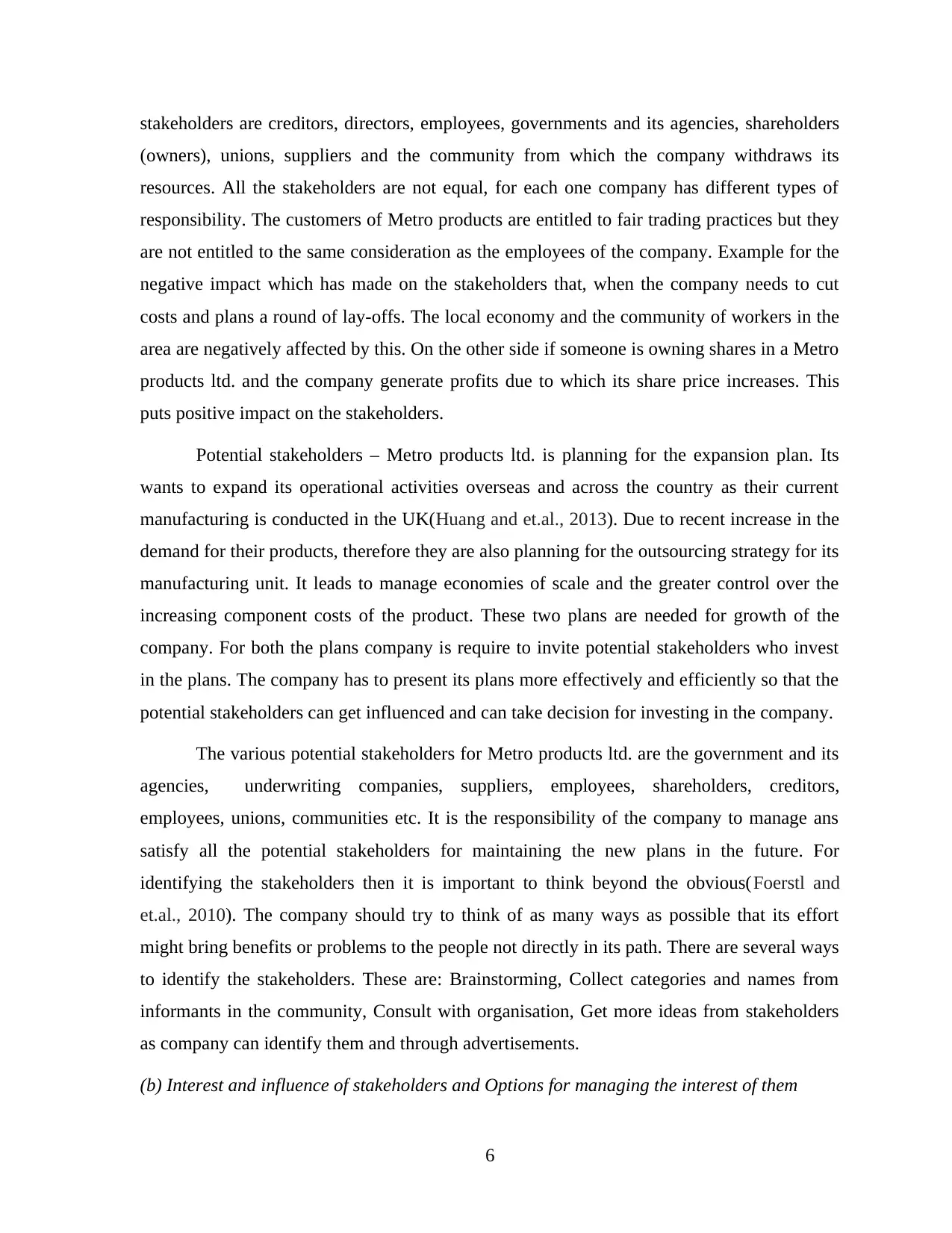
stakeholders are creditors, directors, employees, governments and its agencies, shareholders
(owners), unions, suppliers and the community from which the company withdraws its
resources. All the stakeholders are not equal, for each one company has different types of
responsibility. The customers of Metro products are entitled to fair trading practices but they
are not entitled to the same consideration as the employees of the company. Example for the
negative impact which has made on the stakeholders that, when the company needs to cut
costs and plans a round of lay-offs. The local economy and the community of workers in the
area are negatively affected by this. On the other side if someone is owning shares in a Metro
products ltd. and the company generate profits due to which its share price increases. This
puts positive impact on the stakeholders.
Potential stakeholders – Metro products ltd. is planning for the expansion plan. Its
wants to expand its operational activities overseas and across the country as their current
manufacturing is conducted in the UK(Huang and et.al., 2013). Due to recent increase in the
demand for their products, therefore they are also planning for the outsourcing strategy for its
manufacturing unit. It leads to manage economies of scale and the greater control over the
increasing component costs of the product. These two plans are needed for growth of the
company. For both the plans company is require to invite potential stakeholders who invest
in the plans. The company has to present its plans more effectively and efficiently so that the
potential stakeholders can get influenced and can take decision for investing in the company.
The various potential stakeholders for Metro products ltd. are the government and its
agencies, underwriting companies, suppliers, employees, shareholders, creditors,
employees, unions, communities etc. It is the responsibility of the company to manage ans
satisfy all the potential stakeholders for maintaining the new plans in the future. For
identifying the stakeholders then it is important to think beyond the obvious(Foerstl and
et.al., 2010). The company should try to think of as many ways as possible that its effort
might bring benefits or problems to the people not directly in its path. There are several ways
to identify the stakeholders. These are: Brainstorming, Collect categories and names from
informants in the community, Consult with organisation, Get more ideas from stakeholders
as company can identify them and through advertisements.
(b) Interest and influence of stakeholders and Options for managing the interest of them
6
(owners), unions, suppliers and the community from which the company withdraws its
resources. All the stakeholders are not equal, for each one company has different types of
responsibility. The customers of Metro products are entitled to fair trading practices but they
are not entitled to the same consideration as the employees of the company. Example for the
negative impact which has made on the stakeholders that, when the company needs to cut
costs and plans a round of lay-offs. The local economy and the community of workers in the
area are negatively affected by this. On the other side if someone is owning shares in a Metro
products ltd. and the company generate profits due to which its share price increases. This
puts positive impact on the stakeholders.
Potential stakeholders – Metro products ltd. is planning for the expansion plan. Its
wants to expand its operational activities overseas and across the country as their current
manufacturing is conducted in the UK(Huang and et.al., 2013). Due to recent increase in the
demand for their products, therefore they are also planning for the outsourcing strategy for its
manufacturing unit. It leads to manage economies of scale and the greater control over the
increasing component costs of the product. These two plans are needed for growth of the
company. For both the plans company is require to invite potential stakeholders who invest
in the plans. The company has to present its plans more effectively and efficiently so that the
potential stakeholders can get influenced and can take decision for investing in the company.
The various potential stakeholders for Metro products ltd. are the government and its
agencies, underwriting companies, suppliers, employees, shareholders, creditors,
employees, unions, communities etc. It is the responsibility of the company to manage ans
satisfy all the potential stakeholders for maintaining the new plans in the future. For
identifying the stakeholders then it is important to think beyond the obvious(Foerstl and
et.al., 2010). The company should try to think of as many ways as possible that its effort
might bring benefits or problems to the people not directly in its path. There are several ways
to identify the stakeholders. These are: Brainstorming, Collect categories and names from
informants in the community, Consult with organisation, Get more ideas from stakeholders
as company can identify them and through advertisements.
(b) Interest and influence of stakeholders and Options for managing the interest of them
6
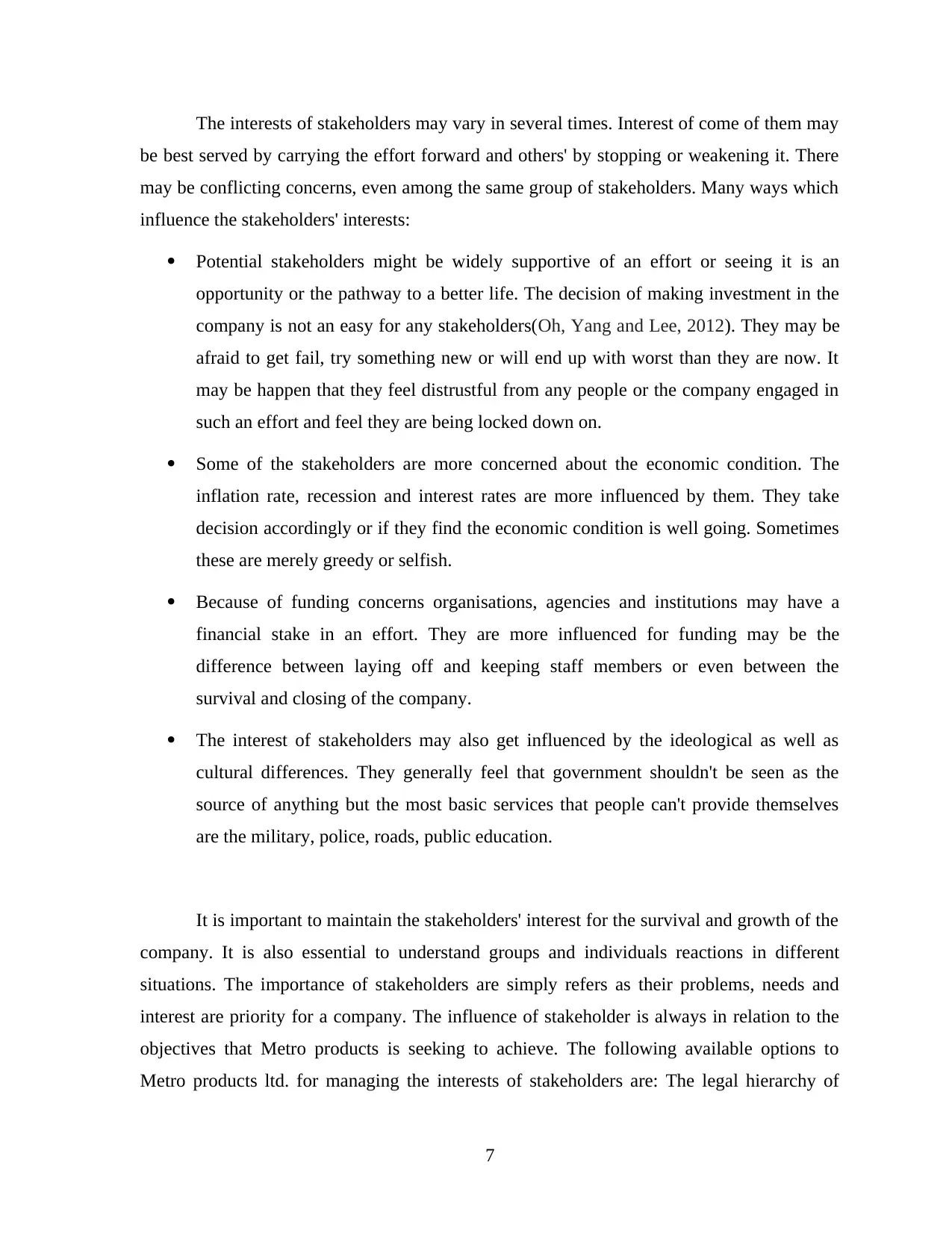
The interests of stakeholders may vary in several times. Interest of come of them may
be best served by carrying the effort forward and others' by stopping or weakening it. There
may be conflicting concerns, even among the same group of stakeholders. Many ways which
influence the stakeholders' interests:
Potential stakeholders might be widely supportive of an effort or seeing it is an
opportunity or the pathway to a better life. The decision of making investment in the
company is not an easy for any stakeholders(Oh, Yang and Lee, 2012). They may be
afraid to get fail, try something new or will end up with worst than they are now. It
may be happen that they feel distrustful from any people or the company engaged in
such an effort and feel they are being locked down on.
Some of the stakeholders are more concerned about the economic condition. The
inflation rate, recession and interest rates are more influenced by them. They take
decision accordingly or if they find the economic condition is well going. Sometimes
these are merely greedy or selfish.
Because of funding concerns organisations, agencies and institutions may have a
financial stake in an effort. They are more influenced for funding may be the
difference between laying off and keeping staff members or even between the
survival and closing of the company.
The interest of stakeholders may also get influenced by the ideological as well as
cultural differences. They generally feel that government shouldn't be seen as the
source of anything but the most basic services that people can't provide themselves
are the military, police, roads, public education.
It is important to maintain the stakeholders' interest for the survival and growth of the
company. It is also essential to understand groups and individuals reactions in different
situations. The importance of stakeholders are simply refers as their problems, needs and
interest are priority for a company. The influence of stakeholder is always in relation to the
objectives that Metro products is seeking to achieve. The following available options to
Metro products ltd. for managing the interests of stakeholders are: The legal hierarchy of
7
be best served by carrying the effort forward and others' by stopping or weakening it. There
may be conflicting concerns, even among the same group of stakeholders. Many ways which
influence the stakeholders' interests:
Potential stakeholders might be widely supportive of an effort or seeing it is an
opportunity or the pathway to a better life. The decision of making investment in the
company is not an easy for any stakeholders(Oh, Yang and Lee, 2012). They may be
afraid to get fail, try something new or will end up with worst than they are now. It
may be happen that they feel distrustful from any people or the company engaged in
such an effort and feel they are being locked down on.
Some of the stakeholders are more concerned about the economic condition. The
inflation rate, recession and interest rates are more influenced by them. They take
decision accordingly or if they find the economic condition is well going. Sometimes
these are merely greedy or selfish.
Because of funding concerns organisations, agencies and institutions may have a
financial stake in an effort. They are more influenced for funding may be the
difference between laying off and keeping staff members or even between the
survival and closing of the company.
The interest of stakeholders may also get influenced by the ideological as well as
cultural differences. They generally feel that government shouldn't be seen as the
source of anything but the most basic services that people can't provide themselves
are the military, police, roads, public education.
It is important to maintain the stakeholders' interest for the survival and growth of the
company. It is also essential to understand groups and individuals reactions in different
situations. The importance of stakeholders are simply refers as their problems, needs and
interest are priority for a company. The influence of stakeholder is always in relation to the
objectives that Metro products is seeking to achieve. The following available options to
Metro products ltd. for managing the interests of stakeholders are: The legal hierarchy of
7
⊘ This is a preview!⊘
Do you want full access?
Subscribe today to unlock all pages.

Trusted by 1+ million students worldwide
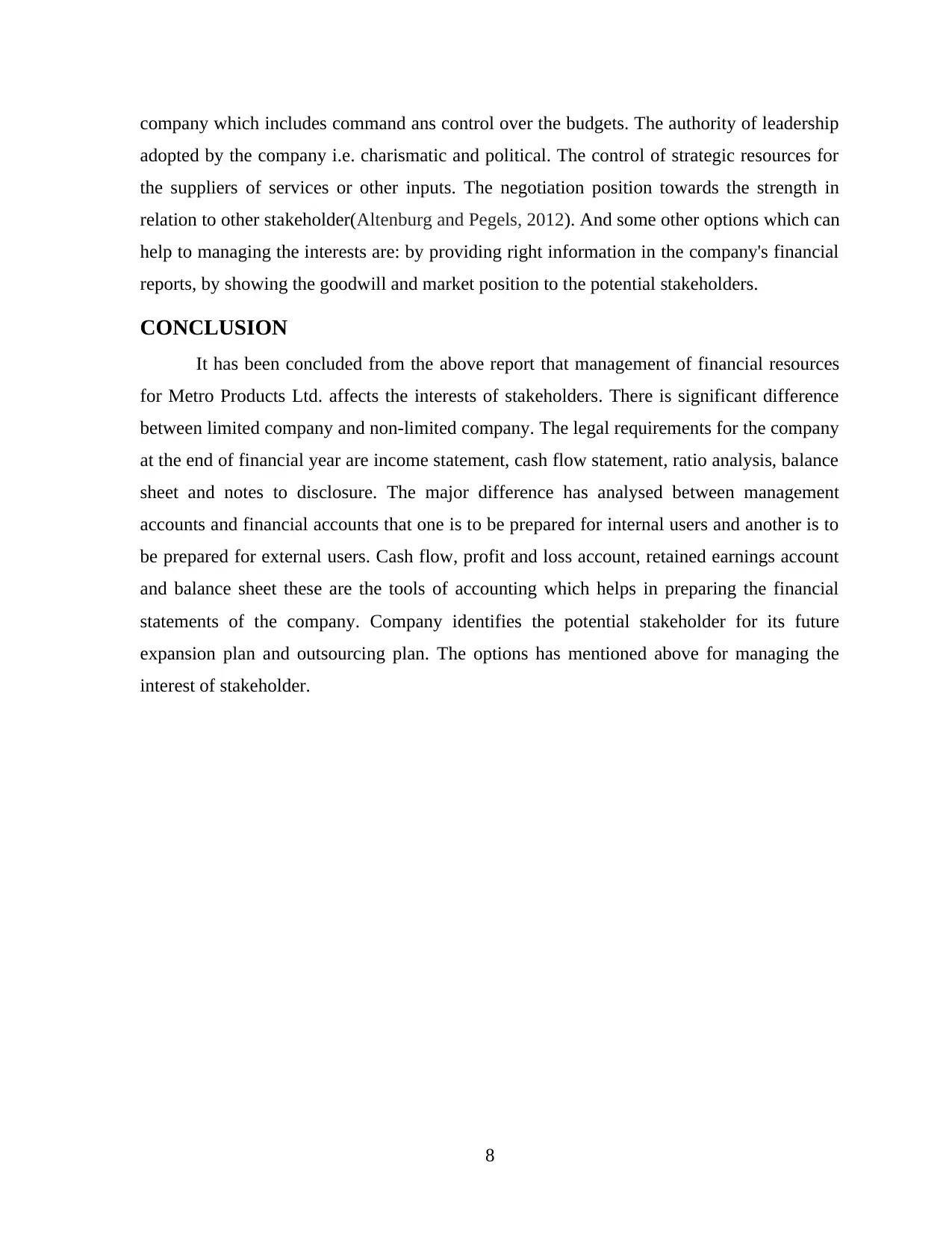
company which includes command ans control over the budgets. The authority of leadership
adopted by the company i.e. charismatic and political. The control of strategic resources for
the suppliers of services or other inputs. The negotiation position towards the strength in
relation to other stakeholder(Altenburg and Pegels, 2012). And some other options which can
help to managing the interests are: by providing right information in the company's financial
reports, by showing the goodwill and market position to the potential stakeholders.
CONCLUSION
It has been concluded from the above report that management of financial resources
for Metro Products Ltd. affects the interests of stakeholders. There is significant difference
between limited company and non-limited company. The legal requirements for the company
at the end of financial year are income statement, cash flow statement, ratio analysis, balance
sheet and notes to disclosure. The major difference has analysed between management
accounts and financial accounts that one is to be prepared for internal users and another is to
be prepared for external users. Cash flow, profit and loss account, retained earnings account
and balance sheet these are the tools of accounting which helps in preparing the financial
statements of the company. Company identifies the potential stakeholder for its future
expansion plan and outsourcing plan. The options has mentioned above for managing the
interest of stakeholder.
8
adopted by the company i.e. charismatic and political. The control of strategic resources for
the suppliers of services or other inputs. The negotiation position towards the strength in
relation to other stakeholder(Altenburg and Pegels, 2012). And some other options which can
help to managing the interests are: by providing right information in the company's financial
reports, by showing the goodwill and market position to the potential stakeholders.
CONCLUSION
It has been concluded from the above report that management of financial resources
for Metro Products Ltd. affects the interests of stakeholders. There is significant difference
between limited company and non-limited company. The legal requirements for the company
at the end of financial year are income statement, cash flow statement, ratio analysis, balance
sheet and notes to disclosure. The major difference has analysed between management
accounts and financial accounts that one is to be prepared for internal users and another is to
be prepared for external users. Cash flow, profit and loss account, retained earnings account
and balance sheet these are the tools of accounting which helps in preparing the financial
statements of the company. Company identifies the potential stakeholder for its future
expansion plan and outsourcing plan. The options has mentioned above for managing the
interest of stakeholder.
8
Paraphrase This Document
Need a fresh take? Get an instant paraphrase of this document with our AI Paraphraser
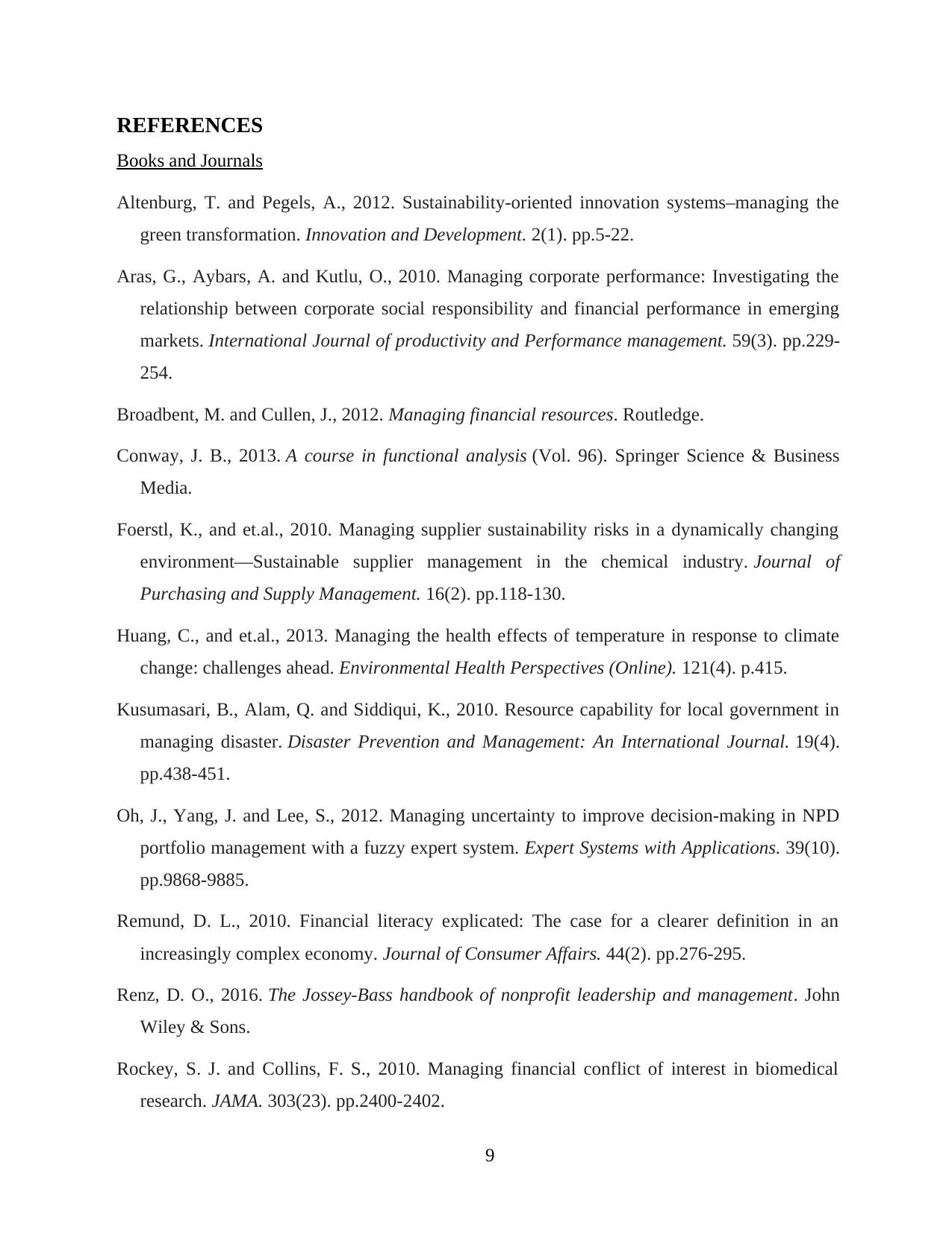
REFERENCES
Books and Journals
Altenburg, T. and Pegels, A., 2012. Sustainability-oriented innovation systems–managing the
green transformation. Innovation and Development. 2(1). pp.5-22.
Aras, G., Aybars, A. and Kutlu, O., 2010. Managing corporate performance: Investigating the
relationship between corporate social responsibility and financial performance in emerging
markets. International Journal of productivity and Performance management. 59(3). pp.229-
254.
Broadbent, M. and Cullen, J., 2012. Managing financial resources. Routledge.
Conway, J. B., 2013. A course in functional analysis (Vol. 96). Springer Science & Business
Media.
Foerstl, K., and et.al., 2010. Managing supplier sustainability risks in a dynamically changing
environment—Sustainable supplier management in the chemical industry. Journal of
Purchasing and Supply Management. 16(2). pp.118-130.
Huang, C., and et.al., 2013. Managing the health effects of temperature in response to climate
change: challenges ahead. Environmental Health Perspectives (Online). 121(4). p.415.
Kusumasari, B., Alam, Q. and Siddiqui, K., 2010. Resource capability for local government in
managing disaster. Disaster Prevention and Management: An International Journal. 19(4).
pp.438-451.
Oh, J., Yang, J. and Lee, S., 2012. Managing uncertainty to improve decision-making in NPD
portfolio management with a fuzzy expert system. Expert Systems with Applications. 39(10).
pp.9868-9885.
Remund, D. L., 2010. Financial literacy explicated: The case for a clearer definition in an
increasingly complex economy. Journal of Consumer Affairs. 44(2). pp.276-295.
Renz, D. O., 2016. The Jossey-Bass handbook of nonprofit leadership and management. John
Wiley & Sons.
Rockey, S. J. and Collins, F. S., 2010. Managing financial conflict of interest in biomedical
research. JAMA. 303(23). pp.2400-2402.
9
Books and Journals
Altenburg, T. and Pegels, A., 2012. Sustainability-oriented innovation systems–managing the
green transformation. Innovation and Development. 2(1). pp.5-22.
Aras, G., Aybars, A. and Kutlu, O., 2010. Managing corporate performance: Investigating the
relationship between corporate social responsibility and financial performance in emerging
markets. International Journal of productivity and Performance management. 59(3). pp.229-
254.
Broadbent, M. and Cullen, J., 2012. Managing financial resources. Routledge.
Conway, J. B., 2013. A course in functional analysis (Vol. 96). Springer Science & Business
Media.
Foerstl, K., and et.al., 2010. Managing supplier sustainability risks in a dynamically changing
environment—Sustainable supplier management in the chemical industry. Journal of
Purchasing and Supply Management. 16(2). pp.118-130.
Huang, C., and et.al., 2013. Managing the health effects of temperature in response to climate
change: challenges ahead. Environmental Health Perspectives (Online). 121(4). p.415.
Kusumasari, B., Alam, Q. and Siddiqui, K., 2010. Resource capability for local government in
managing disaster. Disaster Prevention and Management: An International Journal. 19(4).
pp.438-451.
Oh, J., Yang, J. and Lee, S., 2012. Managing uncertainty to improve decision-making in NPD
portfolio management with a fuzzy expert system. Expert Systems with Applications. 39(10).
pp.9868-9885.
Remund, D. L., 2010. Financial literacy explicated: The case for a clearer definition in an
increasingly complex economy. Journal of Consumer Affairs. 44(2). pp.276-295.
Renz, D. O., 2016. The Jossey-Bass handbook of nonprofit leadership and management. John
Wiley & Sons.
Rockey, S. J. and Collins, F. S., 2010. Managing financial conflict of interest in biomedical
research. JAMA. 303(23). pp.2400-2402.
9
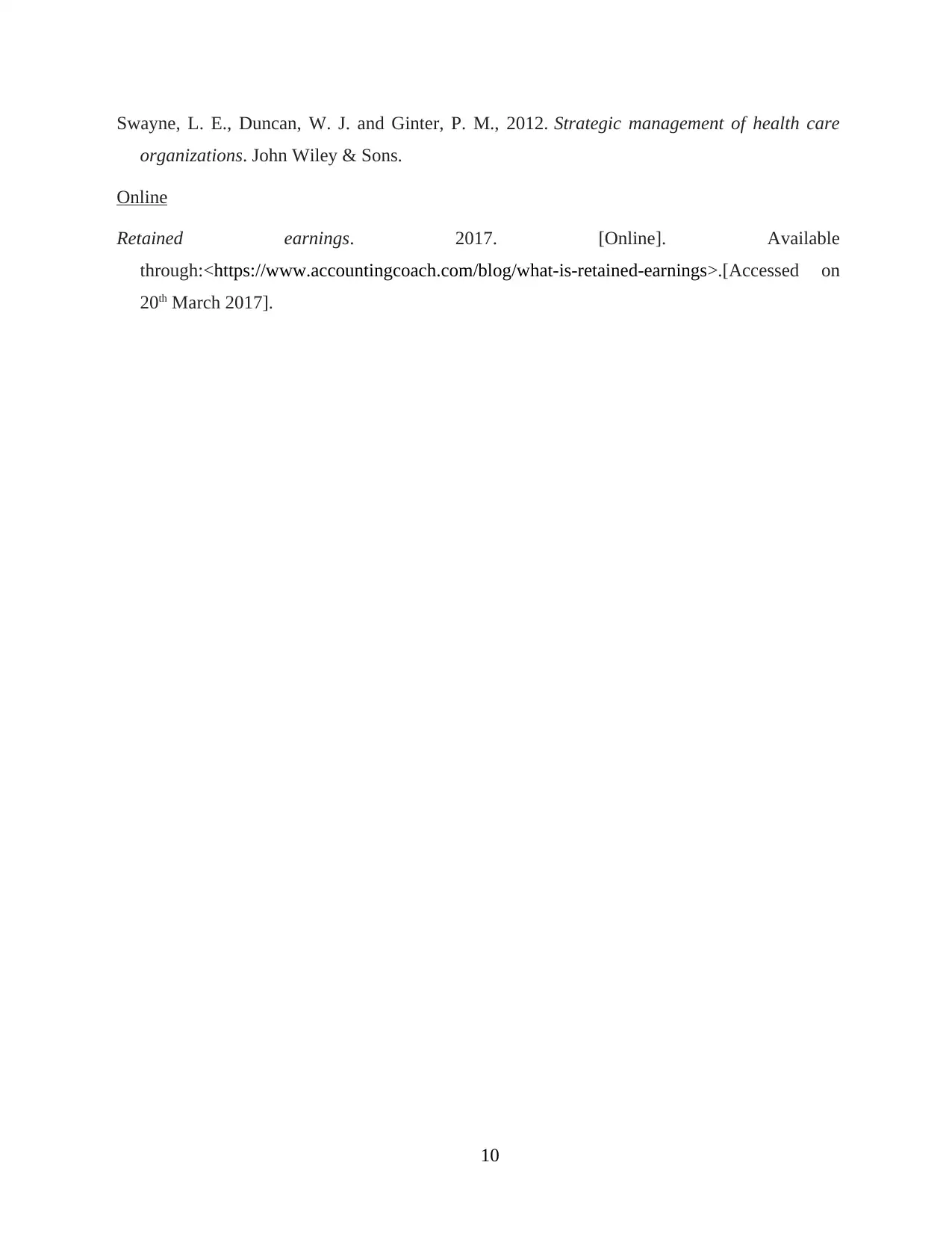
Swayne, L. E., Duncan, W. J. and Ginter, P. M., 2012. Strategic management of health care
organizations. John Wiley & Sons.
Online
Retained earnings. 2017. [Online]. Available
through:<https://www.accountingcoach.com/blog/what-is-retained-earnings>.[Accessed on
20th March 2017].
10
organizations. John Wiley & Sons.
Online
Retained earnings. 2017. [Online]. Available
through:<https://www.accountingcoach.com/blog/what-is-retained-earnings>.[Accessed on
20th March 2017].
10
⊘ This is a preview!⊘
Do you want full access?
Subscribe today to unlock all pages.

Trusted by 1+ million students worldwide
1 out of 12
Related Documents
Your All-in-One AI-Powered Toolkit for Academic Success.
+13062052269
info@desklib.com
Available 24*7 on WhatsApp / Email
![[object Object]](/_next/static/media/star-bottom.7253800d.svg)
Unlock your academic potential
Copyright © 2020–2025 A2Z Services. All Rights Reserved. Developed and managed by ZUCOL.





